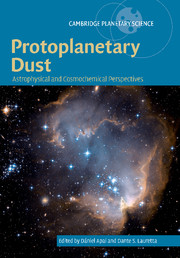Book contents
- Frontmatter
- Contents
- List of contributing authors
- Preface
- Acknowledgments
- 1 Planet formation and protoplanetary dust
- 2 The origins of protoplanetary dust and the formation of accretion disks
- 3 Evolution of protoplanetary disk structures
- 4 Chemical and isotopic evolution of the solar nebula and protoplanetary disks
- 5 Laboratory studies of simple dust analogs in astrophysical environments
- 6 Dust composition in protoplanetary disks
- 7 Dust particle size evolution
- 8 Thermal processing in protoplanetary nebulae
- 9 The clearing of protoplanetary disks and of the proto-solar nebula
- 10 Accretion of planetesimals and the formation of rocky planets
- Appendix 1 Common minerals in the Solar System
- Appendix 2 Mass spectrometry
- Appendix 3 Basics of light absorption and scattering theory
- Glossary
- Index
3 - Evolution of protoplanetary disk structures
Published online by Cambridge University Press: 24 February 2010
- Frontmatter
- Contents
- List of contributing authors
- Preface
- Acknowledgments
- 1 Planet formation and protoplanetary dust
- 2 The origins of protoplanetary dust and the formation of accretion disks
- 3 Evolution of protoplanetary disk structures
- 4 Chemical and isotopic evolution of the solar nebula and protoplanetary disks
- 5 Laboratory studies of simple dust analogs in astrophysical environments
- 6 Dust composition in protoplanetary disks
- 7 Dust particle size evolution
- 8 Thermal processing in protoplanetary nebulae
- 9 The clearing of protoplanetary disks and of the proto-solar nebula
- 10 Accretion of planetesimals and the formation of rocky planets
- Appendix 1 Common minerals in the Solar System
- Appendix 2 Mass spectrometry
- Appendix 3 Basics of light absorption and scattering theory
- Glossary
- Index
Summary
Abstract In this chapter, we review the general properties of protoplanetary disks and how the gaseous and solid components contained within evolve. We focus on the models that are currently used to describe them while highlighting the successes that these models have had in explaining the properties of disks and primitive materials in our Solar System. We close with a discussion of the open issues that must be addressed by future research in order to develop fully our understanding of protoplanetary disk structures.
Protoplanetary disks are natural consequences of star formation, being composed of the molecular cloud material that had too much angular momentum to fall directly onto their central stars. While protoplanetary disks are common around young stars, observations of these objects indicate that they exhibit a range of properties, and it is unclear which, if any, of the objects that have been observed are good analogs for the solar nebula – the protoplanetary disk from which our own planetary system formed. As an example of this caveat, it is important to note that none of the over 350 (and counting) exoplanetary systems provides a good dynamical or structural analog for our own. In this chapter, we take the approach that protoplanetary disk evolution is a universal process, which can be described by a common set of models and equations, and that the variety of structures and properties that have been observed reflect a range of different starting conditions from which, and environments within which, these objects evolved.
- Type
- Chapter
- Information
- Protoplanetary DustAstrophysical and Cosmochemical Perspectives, pp. 66 - 96Publisher: Cambridge University PressPrint publication year: 2010
- 2
- Cited by

